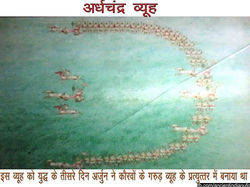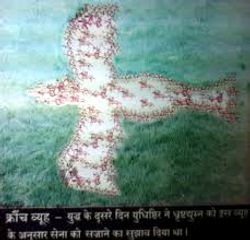
International Gatka Organisation
Sikh Martial Arts
A military dicipline for all mankind
Khalsa Akaal Puraak ki fauj, Pargatiou Khalsa Parmata ki Maouj

Army Formation
Chaturanga - Chess "game of war", in each game there are a king, a councilor, two elephants, two horses, two chariots, and eight foot-soldiers. From the references to this game in the Rg Veda and the Atharva Veda and in the Buddhists and Jaina books, it must have been very popular in ancient India. The Persian term Chatrang and the Arabic Shatrang are forms of the Sanskrit Chaturanga.
Caturangabala.
"In the institutes of menu (Chap. VII sec 185) we learn that the constitution of the army was sixfold,
-
elephants
-
cavalry
-
cars
-
infantry
-
officers and
-
attendants.
The division was, however, practically into the four fiorst parts only. ****
**** "To this fourfold division of armies into elephants, chariots, cavalry, and infantry our game of chess, said Firdusi to have been introduced by an ambassador from the King of Kanauj to the court of Naushirvan, or by Sassa, son of Dahir, in the reign of Bahram, King of Persia, bears interesting witness.
The "castle" represented the howdahs carried by the elephants, which the Greeks in the expedition of Alexander magnified into castle.
The "bishop" take the place of cars, and where we have a "Queen" they have a "Mantri" or minister of state-a leader who mingles everywhere in the fight.
The "Knights" and "pawns" represent the two other classes"
Cf.Translation of the "Siyaru-! Muta-akhkhirin." "review of Modern Times" Calcutta, 1789 Tom. I., p.72, note 6
The organization of the Indian army which came to be known as Caturanga, both in epic Sanskrit and Pali literature, was based on the ancient game.
During the course of the battle a commander would order special formations know as (VYUHAS).
Each Battel Formation had it own purpose - defensive or offensive
Each formation had its specific strengths and weaknesses. The Mahābhārata lists the following:
1. Krauncha vyuha (heron formation)
2. Makara vyuha (crocodile formation)
3. Kurma vyuha (tortoise or turtle formation)
4. Trishula vyuha (trident formation)
5. Chakra vyuha (wheel or discus formation)
6. Kamala vyuha or Padma vyuha (lotus formation)
7. Garud vyuha (eagle formation)
8. Oormi vyuha (ocean formation)
9. Mandala vyuha (galaxy formation)
10. Vajra vyuha (diamond or thunderbolt formation)
11. Shakata vyuha (box or cart formation)
12. Asura vyuha (demon formation)
13. Deva vyuha (divine formation)
14. Soochi vyuha (needle formation)
15. Sringataka vyuha (horned formation)
16. Chandrakala vyuha (crescent or curved blade formation)
17. Mala vyuha (garland formation)
It is not clear what the formations actually indicate. They may be arrangements of bear resemblance to animals, or they may be names given to battle strategies
Each army consisted of several divisions;
The Kauravas had 11 while the Pandavas controlled 7.
A division (akshauhini) includes 21,870 chariots and chariot-riders,
21,870 elephants and riders,
65,610 horses and riders, and
109,350 foot-soldiers (in a ratio of 1:1:3:5).
The combined number of warriors and soldiers in both armies was approximately 3.94 million.[15] Each Akshohini was under a commander or a general, apart from the Commander in chief or the generalissimo who was the head of the entire army.
An Akshauhini (Sanskrit: अक्षौहिणी), was an ancient battle formation that consisted of 21,870 chariots (Sanskrit ratha); 21,870 elephants; 65,610 cavalry and 109,350 infantry, as per the Mahabharata (Adi Parva 2.15-23). The ratio is 1 chariot : 1 elephant : 3 cavalry : 5 infantry soldiers. In each of these large number groups (65,610, etc.), the digits add up to 18.
It is said that the size of Pandavas‘ army in the Kurukshetra war was 7 akshauhinis, and those of Kauravas 11 akshauhinis.
The count is arrived as follows:
One elephant (Gaja), one chariot (Ratha), three horses (Ashwa) and five foot soldiers (Padhata) form a Patti;
Three Pattis form a Sena-Mukha;
Three Sena-Mukhas make a Gulma;
Three Gulmas a Gana;
Three Ganas a Vahini;
Three Vahinis a Pruthana;
Three Pruthanas a Chamu;
Three Chamus a Anikini;
Ten Anikinis form an Akshauhini. Thus an Akshauhini, by calculation, contains 21,870 elephants, 21,870 chariots, 65,610 Horses, and 109,350 foot soldiers.
 |
|---|
 |
 |
 |
 |
 |
 |
 |
 |
 |
 |
